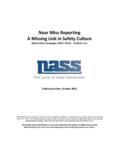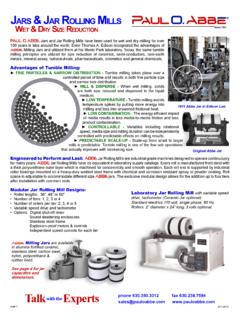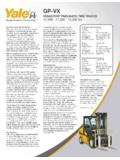Transcription of Electric overhead travelling cranes safety guide - NASS
1 Electric overhead travelling cranes safety guide Doug Ward - October 2013 1 Electric overhead travelling cranes safety guide (Doug Ward October 2013 ) Introduction cranes and lifting accessories used in the lifting and moving o steel products are an essential part of your business operation from both an efficient and cost effective method of handling d materials. They can also be a dangerous item of equipment if not used correctly causing serious injury or even fatality. This information is provided to reinforce the basic principles of pre start checks for all operators of overhead cranes to ensure all equipment is safe for use and remains safe at all times. It should be used in conjunction with your own risk assessment and local safe operating procedures used by your employees. Risk Assessment Although it is a requirement to conduct risk assessments employees should conduct their own personal risk assessment at the start of each shift or new lifting operation.
2 O What is the task? o Do I understand how to do the task correctly? o Do I have the right tools and equipment? o Have I been trained and authorised to operate lifting equipment to be used? o Are the correct controls and procedures in place? Guards warning devices in place Control units Personal Protective Equipment Inspection records Safe working loads (SWL) Exclusion zones If any of the above controls are not in place then stop and inform your immediate manager. Before using any overhead crane or lifting appliance it is important that you carry out some preliminary checks prior to use: Electric overhead travelling cranes safety guide Doug Ward - October 2013 2 Pre Start Checks Ensure that no warning signs are on the crane which can either be attached to the control unit or on the main isolation switch.
3 If an Isolock system is in use do not attempt or ask someone to remove it. Control unit Whichever type of control unit the crane is uses it will normally be fitted with a red stop button which will ether require a key or twist action to release the stop button. When the stop button is released the crane is ready to operate or allows the green button to be pressed to energise the cranes main contactor to allow main motions to work. If any problems are encountered from this point with the oervpati0n of the crane the red stop button should be pressed immediately. This procedure should be carried out for an emergency and followed up by turning the main isolator OFF Pendant control unit Control buttons are housed in a box which is connected to the crane by means of a cable When a button is pressed the hook will move in that direction the harder the button is pressed the faster the crane will travel.
4 Remote control unit A remote pendant is operated by sending a signal to a transmitter on the crane via radio or infrared the remote can be hand held unit or strapped to the operator to allow free movement during lifting operation. (Infrared remotes will have shorter operating distances than that of radio unit.) Electric overhead travelling cranes safety guide Doug Ward - October 2013 3 Some units will be able to operate twin hoist cranes with the facility to operate as either a singular or double hoist unit. If you are required to reposition the slings on a load turn the control unit off to prevent accidental operation overhead crane Checks Check the following: General condition Isolation switch Isolator stop Pendent or remote control unit Hoist rope Hook and safety catch Hoist upper safety limit switch Hoist lower limit safety switch Hoist brake Travel Brakes Long travel Cross travel Anti-collision devices lights and klaxons House keeping Walk ways Electric overhead travelling cranes safety guide Doug Ward - October 2013 4 After use Ancillary equipment: Check any ancillary lifting equipment such as chains and web slings; shackles; multi leg slings; eye bolts; magnets; vacuum lifters; spreader beams chain shorting clutches hooks are fit for purpose and inspected.
5 Carry out a trial lift Ensure that any load is secure and not fastened in position before trying to lift it. Lift the load a couple of inches from the ground or specific location then stop Ensure that the load is stable and secure before continuing with crane travel checks. Never snatch the load as this can cause additional loading on the lifting attachments and the crane leading to potential failure. Complete daily check sheet for crane safe operation. Park the crane in a position of safety at the end or the tracks or in a designated area where it does cause a hazard to other process machinery or personnel. When you have finished using any crane it should be switched off and lifting attachments removed and placed into storage to prevent any unauthorised usage and left in a safe position. Electric overhead travelling cranes safety guide Doug Ward - October 2013 5 The lifting hook should be parked above head height or away from process or mobile equipment such as FLT Lorries etc.
6 If a pendent control is used this should be left in a safe position either in a designated holder or away from where anyone could walk into it or it could become entangled in mobile plant or process machinery. Further Reading: Safe use of lifting equipment: Lifting Operations and Lifting Equipment Regulations 1998 INDG 422 Though examination of Lifting Equipment Beating The Odds - Moving Steel by crane NASS DVD 1st Floor, The Citadel, 190 Corporation Street, Birmingham, B4 6QD | Tel: 0121 200 2288 Electric overhead travelling cranes safety guide Doug Ward - October 2013 6 Example Daily overhead crane & Stock Check Form Name : Location / Area Number : Date : RETURN TO FOREMAN or SITE MANAGER ITEM SERVICABLE COMMENTS Isolation Switches crane Pendant Operational Emergency Stop Operational crane Wire Rope serviceable Upper Hoist Limit Operational Warning lights klaxon Operational Load Hook & safety Catch Chain slings (SWL) Ancillary Lifting attachments Magnets Vacuum - Lifting Beam Walkways clear Loading Bays clear Chain / Web sling storage area Lighting Mobile Platform - product storage Floor condition Personal Protective Equipment safety Signage Electric overhead travelling cranes safety guide Doug Ward - October 2013 7












